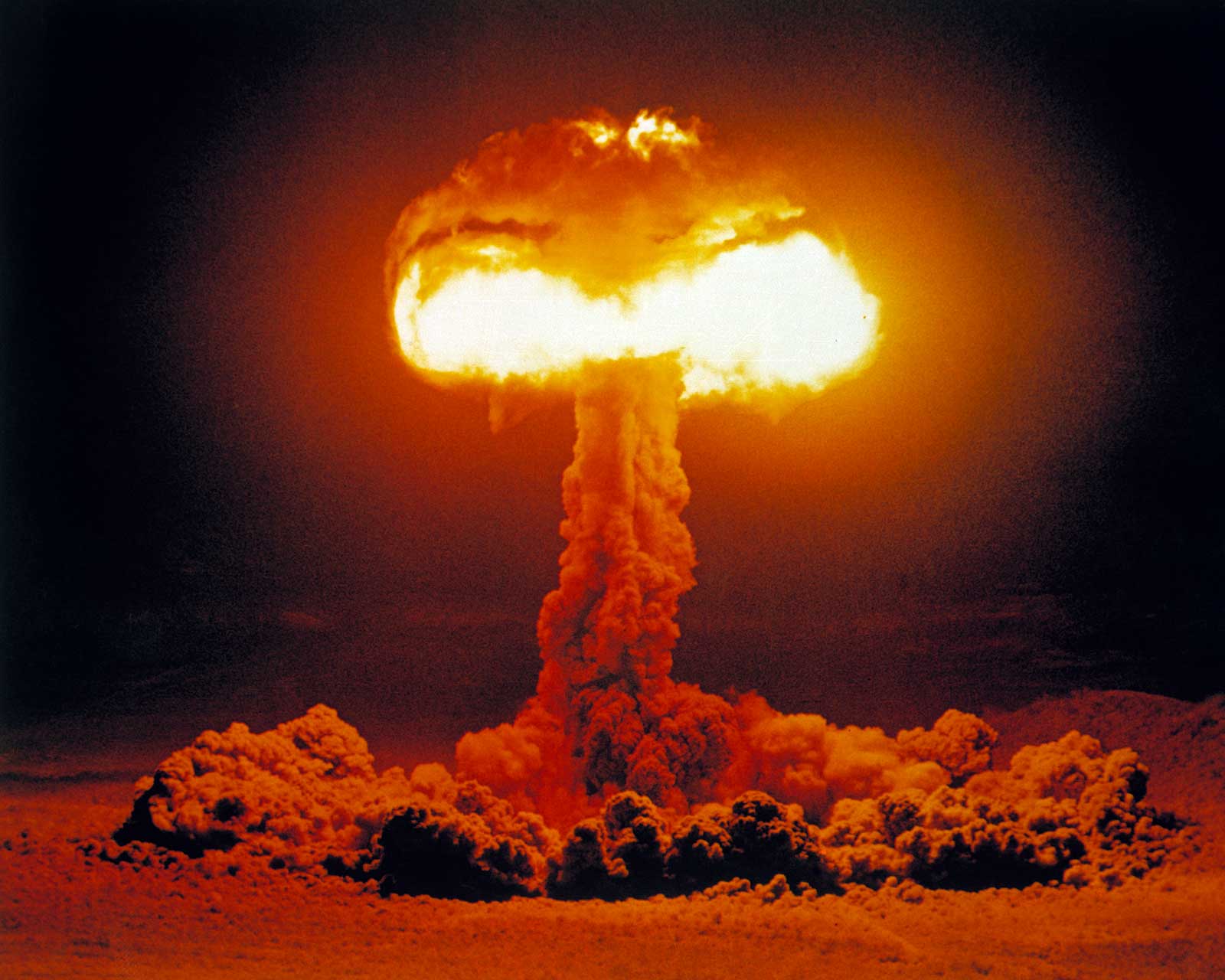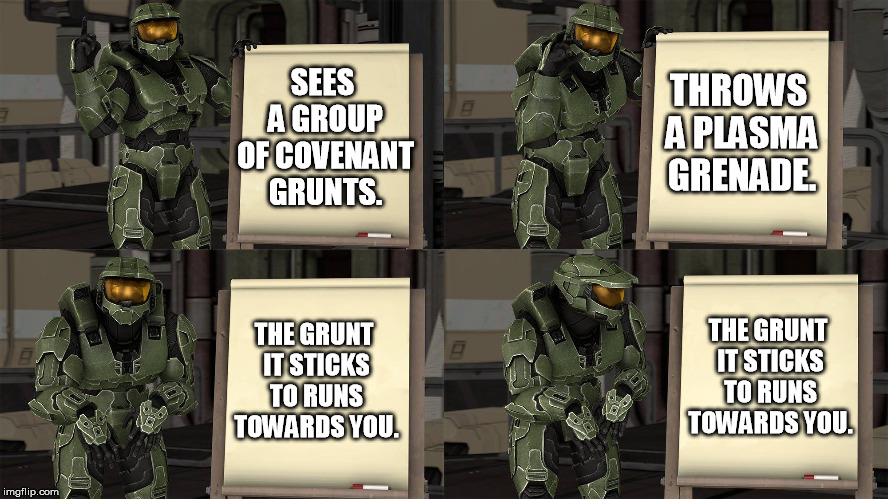Welcome back to another episode of Crossover Armories, where we take a look at weapons from 2 different universes, and see which one is objectively better. This time, we’ll take a look at the Thermal Detonator from Star Wars, and the Plasma Grenade from Halo. But before we can do that, we need to take a look at their stats to see which one can make the bigger boom. So without further ado:
Contestant 1: Thermal Detonator
In this corner, we have the various models of Thermal Detonator from Star Wars!

Thermal detonators are a very old technology by the time of the Original trilogy. Several manufacturers make them in different models, but they are all the same basic weapon. The core of the thermal detonator is a substance that initiates nuclear fusion when hit with energy from the detonator’s trigger. Yes, they’re basically very small pure nuclear fusion bombs. There’s something terrifying about that.

Thermal detonators typically come in spherical models. However, they can come in other shapes too. Stormtrooper thermal detonators, for example, are cylindrical.

The average thermal detonator has an effective blast radius of 5-6 meters. Some models can kill at ranges up to 100 meters though. Canon claims that anything even just slightly beyond that range will not be harmed. However, considering that these are nuclear fusion bombs, this is doubtful.

Thermal detonators are typically armed using timers. Some models have adjustable timers, while others have fixed ones. Proximity fuses are also an option for use in mortars, starfighters, or speeders. They can also feature magnetized casings to allow them to stick to metal. Thermal detonators can also be wired together to form a larger bomb for demolition or antitank purposes. Some people use them for mining, but that’s a bad idea for many reasons unless you know precisely what you’re doing. Lastly, it’s also possible to replace the nuclear fusion charge with an ion charge, basically turning it into an ion grenade for anti-droid, anti-vehicle, or anti-shield work.

Contestant 2: Plasma Grenade
In the other corner, we have the Type-1 Antipersonnel Grenade from Halo, or just the Plasma Grenade for short.

The Plasma Grenade was the standard antipersonnel grenade of the Covenant. The grenade is basically a container for a lot of highly pressurized plasma. When activated, it vents coolant for a short time before finally exploding in a cloud of superheated plasma as the casing destabilizes. This effectively acts as a time-delayed fuse for it.

The Plasma Grenade has a kill radius of 13 feet (~4 meters). Anything within that radius will be incinerated into cinders. However, just because you’re not in that kill radius doesn’t mean that you’re safe. The explosion generates a concussion wave that hits targets outside the kill radius. The plasma will set fire to things and people up to 40 feet (~12 meters) away, and you’ll likely get hit by superheated fragments of things within the kill radius as well.. Not only that, but lightning-like electric currents will crackle in the area for a short time after detonation due to the now highly charged air.

Moreover, the Plasma Grenade’s casing is made of some kind of smart matter that allows it to stick to targets. It uses heat signatures to somehow distinguish between soldiers and vehicles, and the environment. This makes it a fairly useful anti-vehicle/antitank grenade too.

Which is Better?
Both the Thermal Detonator and the Plasma Grenade seem to basically accomplish the same thing with different mechanisms. We’ll have to compare the 2 grenades in different roles to see which one is better.
In the anti-infantry role, it’s clear which one is the winner. Both the average Thermal Detonator and the Plasma Grenade have similar kill radii, with only a 1 meter difference. The thing that makes the difference here is whether you agree with Star Wars canon or not. If you agree, then the Plasma Grenade is the superior grenade by far due to its greatly enhanced injury, fragmentation, and fire-setting range. It basically combines all the advantages of a frag grenade and a Thermal Detonator into a superior weapon. Even if you don’t agree with Star Wars canon though, the Plasma Grenade does still win by a very small margin due to its ability to stick to its targets. A good thrower can stick it onto an enemy soldier, leaving no way to escape it, other than to take you with them.

In the anti-vehicle/antitank role, both the Thermal Detonator and Plasma Grenade are more evenly matched. Both grenades can stick onto their targets, increasing their damage potential. The only difference is that the Plasma Grenade’s casing allows it to stick onto any target, whether it’s made of metal or not, so long as it fit the heat signature it’s looking for. It’s a lot harder to hide a heat signature than it is to hide a metal exterior. So the Plasma Grenade does win again, but only by a slim margin again.
It’s in the demolition role that the Thermal Detonator is finally the winner. The ability to chain multiple of them together makes them much more useful than taking down a building or strongpoint.
Conclusion
In the anti-infantry and anti-vehicle/antitank role, the Plasma Grenade wins. Whether by a large or small margin is up to your belief in Star Wars canon, but the Covenant grenade is still the winner. It’s in the demolition role that the Thermal Detonator shines though, being more useful. If you’re a soldier in a Crossover Battle and you have access to both, you might want to take mostly Plasma Grenades. However, take along a Thermal Detonator or 2 for the odd demo job.


![A Complete Unknown: The Tims They Are A-Changin’ In A Stunning Transformation [Review]](https://thathashtagshow.com/wp-content/uploads/2024/12/3fde8ca3-a6c1-4412-b1d1-cdb51f390118-440x264.jpg)
![Your Place or Mine – Fun Premise, But Not In Love [REVIEW]](https://thathashtagshow.com/wp-content/uploads/2023/02/project_20230215_1131089-01-440x264.png)

![Demon Slayer: Kimetsu No Yaiba – Hashira Training Arc Ep. 7 “Stone Hashira Gyomei Himejima”: Past And Present Colliding [Review]](https://thathashtagshow.com/wp-content/uploads/2024/06/9fe88acc-7789-4a20-99b2-f7e3596701ca-440x264.jpg)